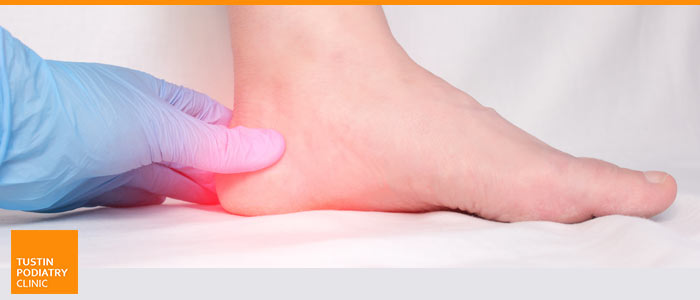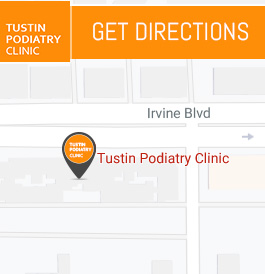4 Questions to Ask Your Heel Spur Specialist
A heel spur is a foot problem that results from a bone-like growth generated by accumulations of calcium that build up on the underside of the heel bone over time. Do you have a heel spur? Talk to our experienced podiatrist Dr. Charles Baik, DPM today at Tustin Podiatry Clinic about treatment for heel spurs. Contact us for more information, or schedule an appointment online! We are conveniently located at 17400 Irvine Blvd. Suite H, Tustin, CA.


Table of Contents:
What does a heel spur feel like?
Is there a difference between heel spurs and plantar fasciitis?
What happens if a heel spur goes untreated?
Who treats heel spurs?
A heel spur, also known as calcaneal spurs, or osteophytes, is a bony, sometimes pointed, hooked, or shelf-like outgrowth, that will extend from underneath the heel toward the middle of the foot. This middle area, or arch area of the foot is also called the plantar fascia. As we age, we become more vulnerable to heel spurs because with age the pads in the heels that provide shock absorption begin to wear down. Also, calcium deposits can build-up under the heel over time, and result in bony protrusions. Other causes are when long-term muscle and ligament strains wear out the soft tissue in the heel, or if there is tearing in the membrane that covers the heel bone. A heel spur will appear up to half an inch long when observed under an x-ray, which is the only way to confirm a heel spur, however, if the doctor is unable to confirm the presence of a heel spur, it may be referred to as heel spur syndrome.
It is possible to have a heel spur and not experience any symptoms at all, and these are only discovered when getting an x-ray for another reason. But some of the more common symptoms of heel spur include:
• Sharp pain in the heel when standing up, especially getting up from bed
• Dull ache in the heal throughout the day
• Swelling around the front part of the heel
• Radiating heat from the heel area
• Visible bone-like protrusion under the heel
• Hard to walk barefoot, feeling of tenderness at the bottom of the heel
A condition known as plantar fasciitis is often confused with heel spurs. Heel spurs will often occur in people who already have plantar fasciitis, as plantar fasciitis increases the risk of developing heel spurs. The important distinction between heel spurs and plantar fasciitis are that heel spurs are a bony protrusion caused by calcium deposits along the plantar fascia. Plantar fasciitis, on the other hand is when the plantar fascia becomes swollen and irritated, causing pain in the heel. Plantar fascia is tissue that connects to the heel and stretches under the sole of the foot. Plantar fasciitis occurs from an excessive amount of force on this part of the foot, which occurs from exercise, walking in excess, wearing shoes with insufficient arch support, and from being overweight or obese.
Another significant difference between plantar fasciitis and heel spurs, is that plantar fasciitis commonly goes away on its own without any treatment, whereas heel spurs will be permanent if not treated medically.
A heel spur is a deposit of calcium that develops on the underside of the heel bone. Roughly ten percent of American adult’s experience heel spurs, and many of those cause very little, if any discomfort. However, for many the pain can be significant, and even debilitating. Because heel spurs do not resolve on their own, if left untreated, mobility may be dramatically affected, and many find difficulty bearing any weight on the affected foot. Untreated, or improperly treated heel spurs can produce a chronic pain condition.
A podiatrist is a doctor of podiatric medicine (DPM) and is specialized in diagnosing and treating problems strictly related to the bones, joints and soft tissue of the foot and ankle. An orthopedic surgeon is also an MD, specifically specialized in the care of bones, ligaments, muscles, tendons and nerves throughout the entire body, which include the foot and ankle.
Both podiatrists and orthopedic doctors are equally qualified, and highly trained to treat foot and ankle problems, including heel spurs.
At Tustin Podiatry Clinic, our team of highly trained, and experienced podiatrists and foot care professionals, take great pride in providing the most advanced and effective treatments and therapies for foot and ankle pain. If you’re experiencing foot or ankle pain, call our clinic, or visit our website to arrange your consultation appointment, or for directions to Tustin Podiatry Clinic. We serve patients from Tustin CA, Irvine CA, Garden Grove CA, Orange CA, Anaheim CA, Costa Mesa CA, and Lake Forest CA.

Additional Services You May Need
▸ Heel Pain Treatment
▸ Laser Fungal Nail Treatment
▸ Ingrown Toenail Treatment
▸ Ankle Sprain Treatment
▸ Foot and Ankle Medicine & Surgery
▸ Orthotics Custom
▸ EPAT/Shockwave Therapy
▸ Hammertoe
▸ Arthritis Treatment
▸ Diabetic Foot Care
▸ Flat Feet Treatment
▸ Foot Warts Treatment
▸ ClarixFlo





